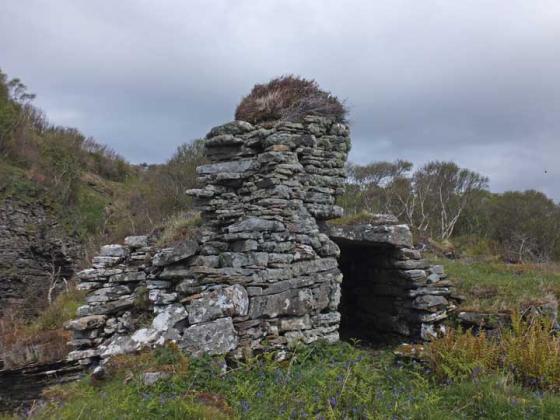.. the Cairn [is] circular, and measures 125 paces round the base. It is reported to have been of a conical shape within the memory of persons living; but that the stones which formed the apex have been carried away by the poor people to assist them in building t heir cottages. However this may be, the Cairn is conical no longer but flat at top; and except here and there, where a few of the stones of which it was originally constructed are visible, it is covered with grass..
.. The discovery [of chambers inside] was made by a poor girl, who related the circumstance to me as follows. One day, when she was sitting on the Cairn, some of the earth near her suddenly gave way, and fell in; presently a large stone followed, -- revealing, to her great surprise and alarm, a dark hole, and showing that the Cairn whereon she had been sitting was hollow. She ran and communicated her discovery to some men; who first threw some stones into the cavern, and then descended.
The account of such very incompetant observers [!] is hardly to be trusted; but I was assured that the tomb contained nothing but a coffin formed by a series of rough flag-stones disposed so as to form a receptacle for the human body; part of a skeleton; and (I believe) an amber bead, together with some other little object which she could not describe.*
The weather was quite bad so he couldn’t go sight seeing – so why not dig into the cairn?
An understanding was speedily entered into with nine active lads, who [..] attacked the stony heap at three different points, under the auspices of divers grave old Gaels; who folding their plaids about them, sat smoking their wee pipes, and predicting between every whiff that the Saxon would not find anything.
Actually they turned out to be right. They kept digging, then it rained a lot and despite the ‘some whiskey, judiciously administered’, the workmen got fed up in the end and downed tools in the rain the next day.
From J.W.B on p36 of the 1841 Gentleman’s Magazine, online at Google books, here.
The RCAHMS database describes it as ‘a large, steep-sided, grass-covered mound bearing trees. It measures about 77ft by 55ft by 13ft in height.’ ‘The capstone of the chamber, said to have been broken in 1832, still leans against the base of the mound on the N side. It is 8ft long, 5ft in maximum width and 1ft thick. A small flat slab lies nearby.‘
*this might have been the grey-green stone wristguard which is mentioned in the RCAHMS notes.






































